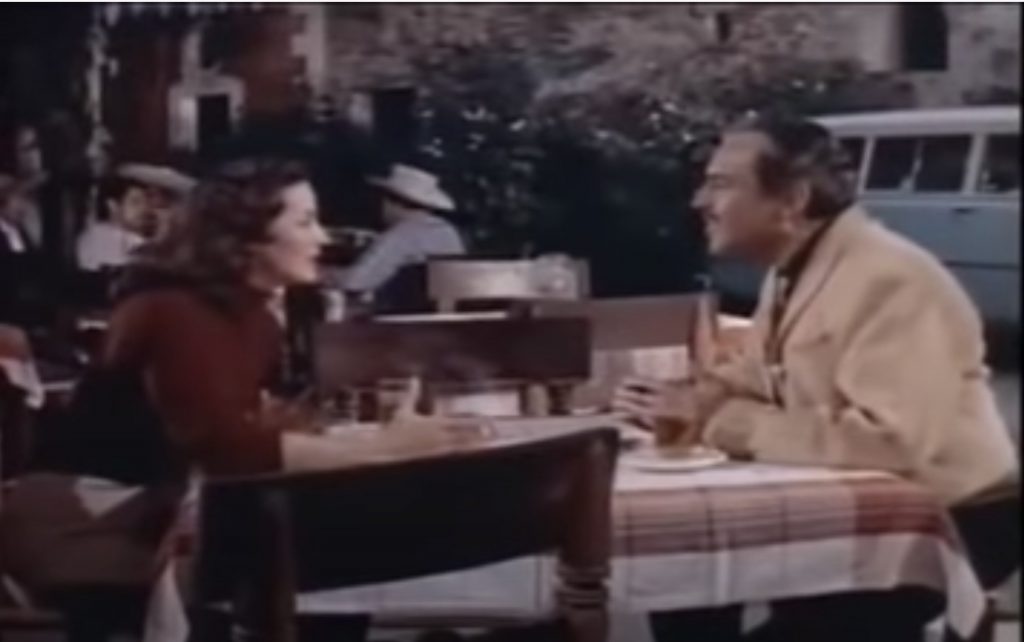Continuing my look at films starring María Félix, here’s a short review of Canasta de cuentos mexicanos [Basket of Mexican Stories] (Julio Bracho, 1956). Adapted from three stories by B Traven, a mysterious author about whom I have previously written in relation to Macario (Roberto Gavaldón, 1959). The voice over in the opening sequence privileges this literary source and tells us that Traven is the acclaimed author of The Treasure of the Sierra Madre (John Huston, 1954) and La rebelión de los colgados [The Rebellion of the Hanged] (Alfredo B. Crevenna and Emilio Fernándex, 1954). Such foregrounding of the literary source is not unusual in Mexican screen adaptations. An anthology film that foregrounds the location of each story Canasta de cuentos mexicanos comprises: “Solución inesperada” [unexpected solution] set in Taxco; “Canasta” [basket] set in Oaxaca, Acapulco, and New York; and “La tigresa” [the tigress] set in Cuernavaca and an unnamed ranch location in Michoacán, Northern Mexico.
Briefly, the stories have unexpected twists. In “Solución inesperada” a husband (Arturo de Cordova) is faced with a dilemma when his son announces his engagement. Thinking that his son’s fiancée is his biological daughter he forbids the wedding but does not want his secret revealed. When he does tell his wife (Lorraine Chanel) after some rumination, this dilemma is upended when she reveals that their son is not his biological son. Both had affairs at about the same time. Thus, the dilemma is resolved without anyone else finding out. “Canasta” considers what happens when modernity confronts indigenous productive capacity and priorities. A honeymooning US couple (Jack Kelly and Marie Blanchard) get their comeuppance when they hope to get rich exploiting an indigenous family weaving baskets. The unnamed (and uncredited) indigenous basket weaver lays out the reasons why he can produce the work cheaply on a small scale, but scaling up for their profit is not possible. Thus, the couple must return to their middle class life and the indigenous family retain their traditional way of life. Both of these are attempts to play with prior assumptions about women (in “Solución inesperada”) and the indigenous (in “Canasta”) with mixed results. They upend and reinforce societal norms.
The final story, “La tigresa” [the tigress] stars María Félix. It also plays with assumptions, but has the most conventional ending of the three. Félix stars as Luisa Bravo -she gets top billing in the opening credits- and her character is as brava (wild, unruly, untamed) as her surname suggests. An adept horsewoman and chess player, she is New York educated with a hot headed temperament which no man has been able to tame. That is, until Carlos Cosio (Pedro Armendáriz) comes into town. Carlos is smitten with her on first sight when he goes to her saddlery to buy a saddle. After a relatively brief and fiery courtship, they marry and she moves to his ranch in the North.

Most of the story is concerned with the courtship watched over by her grandmother and aunt. An intentionally comical pair, they comment on Luisa’s unsuitability for marriage because her foreign education led her astray, “le duele vivir en un mundo en que dominan los hombres” [it hurts her to live in a world dominated by men]. Like many films starring Félix as a feisty, independent character, most screen time is spent on her skills and abilities and how attractive her beauty and intelligence is for men.

Nonetheless, because of the conservative mores of the time, her characters either get punished or tamed for these same characteristics. This is the case in “La tigresa”. In the last few minutes of the narrative, Luisa is dominated by Carlos. Although, interestingly, this is not shown on screen. What we do see is her hand lighting a cigarette and their clothes strewn about the room. All of which suggests that they have (after some months) consummated their marriage. The dialogue in this scene suggests that he has the upper hand, but it’s not unambiguous. In an earlier montage sequence it is implied that Luisa (unlike a ‘good’ wife who should consent only to have children) has a sexual appetite and is turned on by Carlos, a desire heretofore he has refused her. Therefore, is not definitive that he is the one who “won” this dispute. So, the Luisa we come away with is the powerful and capable woman not the submissive that could be suggested by a surface reading of the ending. Such ambiguity is one of the reasons Félix’s star text as independent, rebellious woman persists. The punishment for her transgressive behaviour happens off-screen or is implied, but seldom shown. As Paco Ignacio Taibo I states in his assessment of her performance and casting in the film, “La leyenda de María Félix parecía convenir a la <<Tigresa>> y la <<Tigresa>> encajar en el comportamiento social de María” [María Félix’s reputation was that of a “Tigress” and the “Tigress” matched María’s public self] (2004, 302). He compares her character’s treatment on screen to similar treatment of Elizabeth Taylor and Mary Pickford in their star turns as, “mujeres independientes y autoritarias [quienes] fueron ofrecidas a la venganza del público, en papeles de fierecillas domadas” [independent and assertive women who were offered up for public retribution, in roles as tamed shrews] (Taibo I 2004, 303).
Canasta de cuentos mexicanos is one of several anthology films starring Félix that draws on her star persona. They are a curious style of film that make for interesting compendiums of contemporary Mexico. Reportaje (Emilio Fernández, 1953) is another good example in which her character (in metafictional fashion) is a famous star. Canasta de cuentos mexicanos is one of the three films by the director, Julio Bracho, starring Félix as a seductress. The others are: El monje blanco [the white monk] (1945) and La mujer de todos [everybody’s woman] (1946).
Work Cited
Taibo I, Paco Ignacio. (2004), María Félix: 47 pasos por el cine. Mexico: Ediciones B.